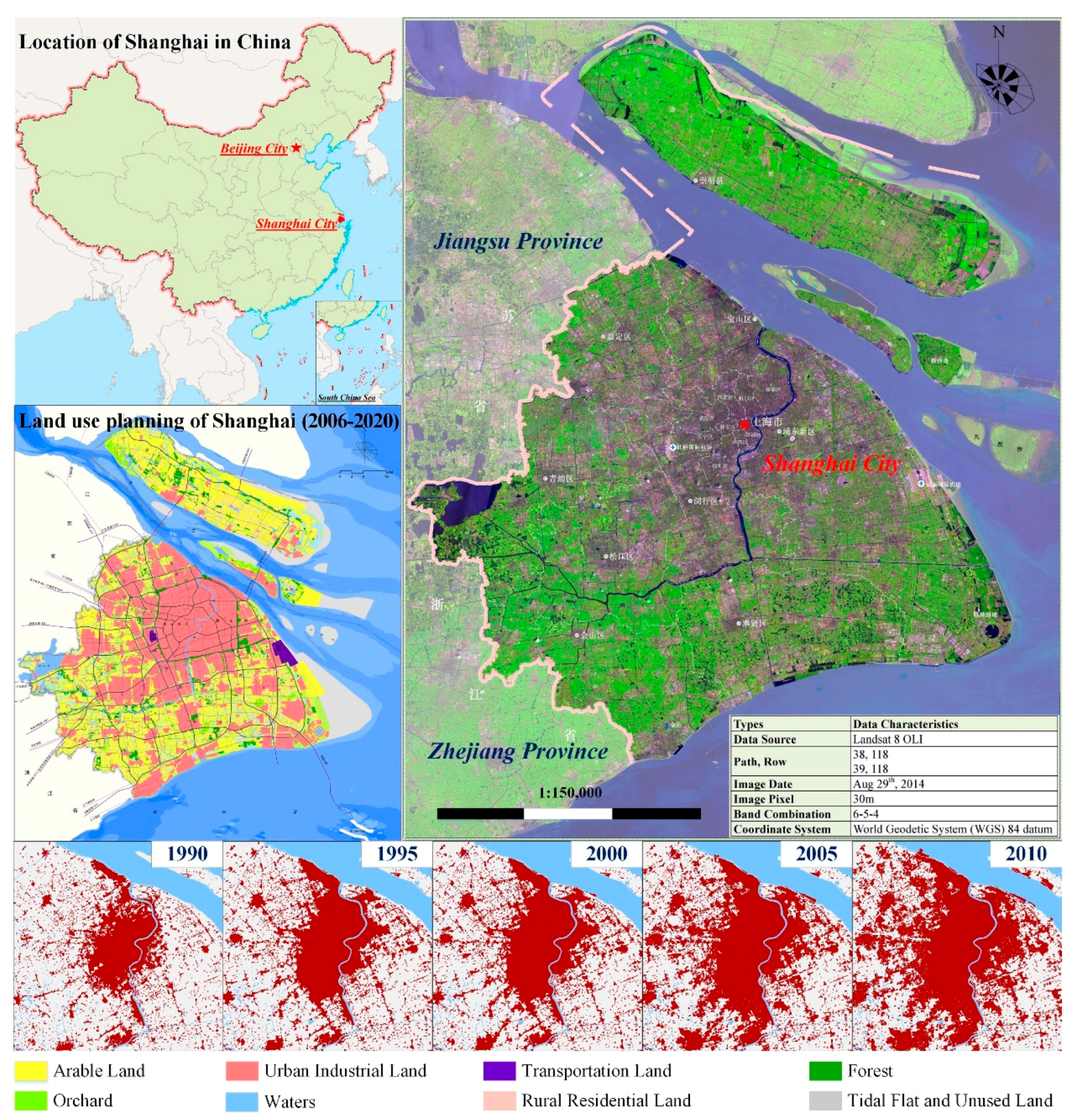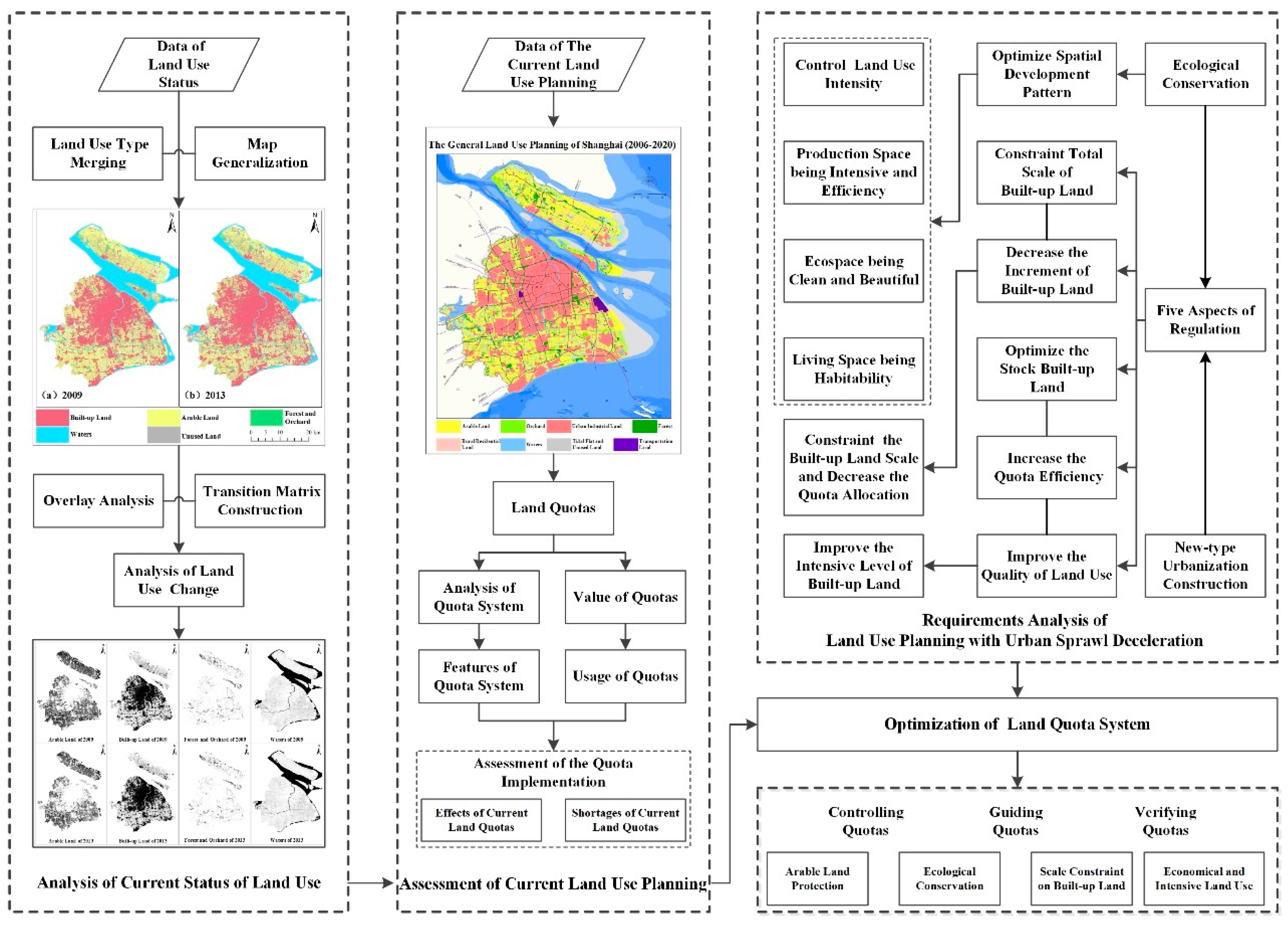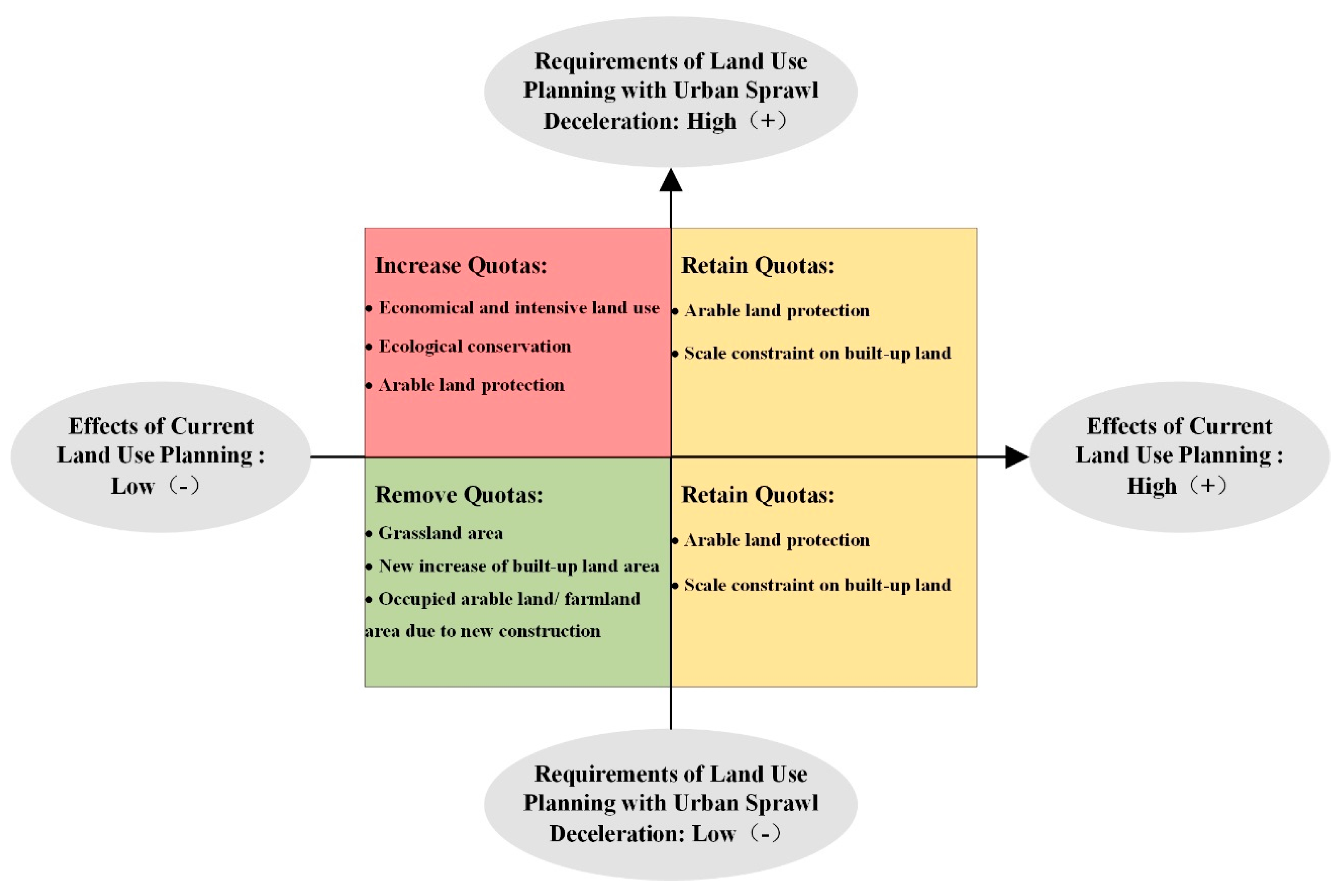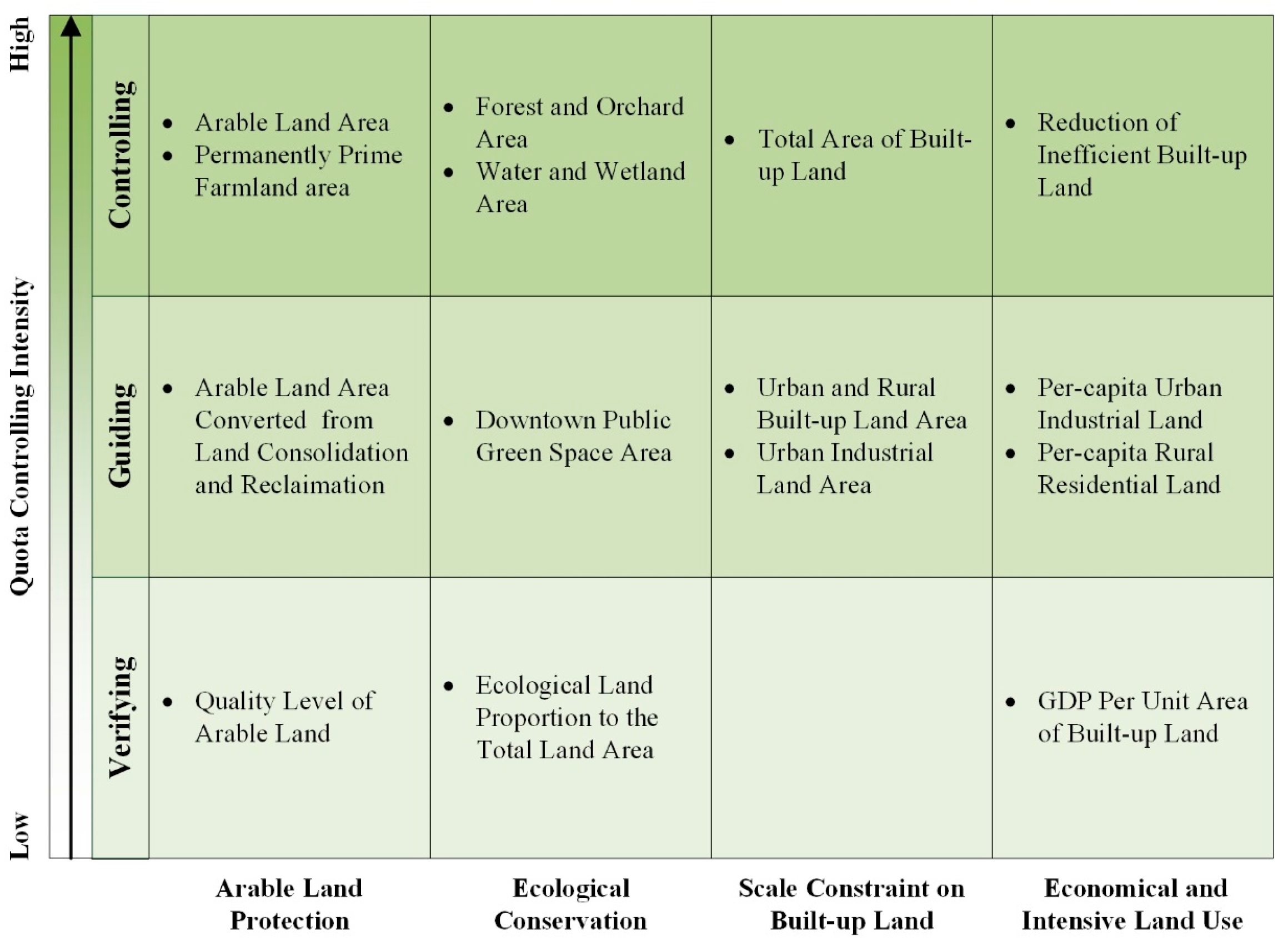Quota Restrictions on Land Use for Decelerating Urban Sprawl of Mega City: A Case Study of Shanghai, China
Abstract
:1. Introduction
2. Study Area and Data Sources
2.1. Study Area
2.2. Data Sources
3. Methods
3.1. Basic Idea and Framework of the CPRR Model
3.2. Analysis of Land Use Changes
3.3. Evaluation of Land Quota Use
4. Results and Discussion
4.1. Analysis of the Current Land Quota System in Shanghai
4.1.1. The Current Status of Land Use in Shanghai
4.1.2. The Current Land Quotas of Shanghai
4.1.3. Effect of the Current Land Quotas of Shanghai
4.2. Optimization of a Land Quota System for Land Use Planning with Urban Sprawl Deceleration
4.2.1. Requirements Analysis of Land Use Planning with Urban Sprawl Deceleration
4.2.2. Optimal Design of a Land Quota System for Land Use Planning with Urban Sprawl Deceleration
4.2.3. Land Quota System for Land Use Planning with Urban Sprawl Deceleration
5. Conclusions
Acknowledgments
Author Contributions
Conflicts of Interest
References
- The Ambassador Anwar Chaudhry: Green Economy and Inclusive Growth under the Global Change. Available online: http://www.gfhsforum.org/news/GD/2012/8/12891022434274.html (accessed on 15 March 2016).
- Ding, C. Building height restrictions, land development and economic costs. Land Use Policy 2013, 30, 485–495. [Google Scholar] [CrossRef]
- Cohen, B. Urbanization in developing countries: Current trends, future projections, and key challenges for sustainability. Technol. Soc. 2006, 28, 63–80. [Google Scholar] [CrossRef]
- McMichael, A.J. The urban environment and health in a world of increasing globalization: Issues for developing countries. Bull. World Health Organ. 2000, 78, 1117–1126. [Google Scholar] [PubMed]
- Bai, X.; Chen, J.; Shi, P. Landscape urbanization and economic growth in china positive feedbacks and sustainability dilemmas. Environ. Sci. Technol. 2011, 46, 132–139. [Google Scholar] [CrossRef] [PubMed]
- Deng, X.; Huang, J.; Rozelle, S.; Zhang, J.; Li, Z. Impact of urbanization on cultivated land changes in China. Land Use Policy 2015, 45, 1–7. [Google Scholar] [CrossRef]
- Yeh, A.G.-O.; Li, X. Economic development and agricultural land loss in the Pearl River Delta, China. Habitat Int. 1999, 23, 373–390. [Google Scholar]
- Han, J.; Hayashi, Y.; Cao, X.; Imura, H. Evaluating land-use change in rapidly urbanizing China: Case study of Shanghai. J. Urban Plan. Dev. 2009, 135, 166–171. [Google Scholar] [CrossRef]
- Wu, K.-Y.; Zhang, H. Land use dynamics, built-up land expansion patterns, and driving forces analysis of the fast-growing Hangzhou metropolitan area, Eastern China (1978–2008). Appl. Geogr. 2012, 34, 137–145. [Google Scholar] [CrossRef]
- Deng, X.; Huang, J.; Rozelle, S.; Uchida, E. Growth, population and industrialization, and urban land expansion of China. J. Urban Econ. 2008, 63, 96–115. [Google Scholar] [CrossRef]
- Güneralp, B.; Seto, K.C. Environmental impacts of urban growth from an integrated dynamic perspective: A case study of Shenzhen, South China. Glob. Environ. Chang. 2008, 18, 720–735. [Google Scholar] [CrossRef]
- Skinner, M.W.; Kuhn, R.G.; Joseph, A.E. Agricultural land protection in China: A case study of local governance in Zhejiang province. Land Use Policy 2001, 18, 329–340. [Google Scholar] [CrossRef]
- Qu, Y.; Sun, S.; Chen, Y. The expansion and strategy of controlling China’s urban construction land. Resour. Sci. 2014, 36, 1–7. [Google Scholar]
- Chen, Y.; Chen, Z.; Xu, G.; Tian, Z. Built-up land efficiency in urban China: Insights from the general land use plan (2006–2020). Habitat Int. 2016, 51, 31–38. [Google Scholar] [CrossRef]
- Chien, S.-S. Local farmland loss and preservation in China—A perspective of quota territorialization. Land Use Policy 2015, 49, 65–74. [Google Scholar] [CrossRef]
- Li, Y.; Li, Y.; Westlund, H.; Liu, Y. Urban–rural transformation in relation to cultivated land conversion in China: Implications for optimizing land use and balanced regional development. Land Use Policy 2015, 47, 218–224. [Google Scholar] [CrossRef]
- Ding, C. Land policy reform in China: Assessment and prospects. Land Use Policy 2003, 20, 109–120. [Google Scholar] [CrossRef]
- Wang, H.; Tao, R.; Wang, L.; Su, F. Farmland preservation and land development rights trading in Zhejiang, china. Habitat Int. 2010, 34, 454–463. [Google Scholar] [CrossRef]
- Tan, R.; Beckmann, V.; van den Berg, L.; Qu, F. Governing farmland conversion: Comparing China with The Netherlands and Germany. Land Use Policy 2009, 26, 961–974. [Google Scholar] [CrossRef]
- Tan, R.; Zhou, T. Decentralization in a centralized system: Project-based governance for land-related public goods provision in China. Land Use Policy 2015, 47, 262–272. [Google Scholar] [CrossRef]
- Yunnan, H. Effects of urban land supply policy on real estate in China: An econometric analysis. J. Real Estate Lit. 2008, 16, 55–72. [Google Scholar]
- Hsing, Y.-T. Land and territorial politics in urban China. China Q. 2006, 187, 575–591. [Google Scholar] [CrossRef]
- Zhong, T.; Mitchell, B.; Huang, X. Success or failure: Evaluating the implementation of China’s national general land use plan (1997–2010). Habitat Int. 2014, 44, 93–101. [Google Scholar] [CrossRef]
- Shi, W.; Zou, B.; Jin, Z.; Shi, X.; Ding, C.; Wang, K.; Zhao, Y.; Zhen, H.; Lin, J.; Shi, N. Master plan targeted at stock and decrement. City Plan. Rev. 2014, 38, 16–21. [Google Scholar]
- Shanghai Deploys the Reducing Operation of Construction Land. Available online: http://www.shgtj.gov.cn/xxbs/shij/201506/t20150623_657117.html (accessed on 21 October 2015).
- Notification about the Printing of the Yangtze River Delta Urban Agglomeration Development Plan. Available online: http://www.gov.cn/xinwen/2016-06/03/content_5079264.htm (accessed on 10 June 2016).
- Zhang, H.; Zhou, L.G.; Chen, M.N.; Ma, W.C. Land use dynamics of the fast-growing Shanghai metropolis, China (1979–2008) and its implications for land use and urban planning policy. Sensors 2011, 11, 1794–1809. [Google Scholar] [CrossRef] [PubMed]
- National Bureau of Statistics of China. Shanghai Statistical Yearbook, 2014; China Statistics Press: Beijing, China, 2015. (In Chinese)
- Yin, J.; Yin, Z.; Zhong, H.; Xu, S.; Hu, X.; Wang, J.; Wu, J. Monitoring urban expansion and land use/land cover changes of Shanghai metropolitan area during the transitional economy (1979–2009) in China. Environ. Monit. Assess. 2011, 177, 609–621. [Google Scholar] [CrossRef] [PubMed]
- Wang, J.; Chen, Y.; Shao, X.; Zhang, Y.; Cao, Y. Land-use changes and policy dimension driving forces in China: Present, trend and future. Land Use Policy 2012, 29, 737–749. [Google Scholar] [CrossRef]
- Shanghai Institute of Land Resource Survey. Assessment of the Implementation of Shanghai’s General Land Use Planning (2006–2020); Shanghai Institute of Land Resource Survey: Shanghai, China, 2015. (In Chinese) [Google Scholar]
- Liu, J.; Zhang, Z.; Xu, X.; Kuang, W.; Zhou, W.; Zhang, S.; Li, R.; Yan, C.; Yu, D.; Wu, S.; et al. Spatial patterns and driving forces of land use change in China in the early 21st century. Acta Geogr. Sin. 2009, 64, 1411–1420. [Google Scholar] [CrossRef]
- Bell, E.J. Markov analysis of land use change—An application of stochastic processes to remotely sensed data. Socio Econ. Plan. Sci. 1974, 8, 311–316. [Google Scholar] [CrossRef]
- Turner, M.G. Spatial simulation of landscape changes in Georgia: A comparison of 3 transition models. Landsc. Ecol. 1987, 1, 29–36. [Google Scholar] [CrossRef]
- Hong, W.; Liu, Y.; Li, M.; Liu, M.; Tong, L. Implementation evaluation methods of overall land use planning. Sci. Technol. Manag. Land Resour. 2013, 30, 68–73. [Google Scholar]
- Shanghai Planning and Land Resource Administration Bureau. Shanghai General Land Use Planning (2006–2020). Available online: http://www.shgtj.gov.cn/tdgl/200812/t20081223_152679.html (accessed on 6 April 2016).
- Shanghai Limits the Total Scale of Construction Land for Development. Available online: http://www.gtzyb.com/yaowen/20140322_60529.shtml (accessed on 2 July 2015).
- Shanghai Promotes the Reducing Operation of construction Land to Break the Tight Constraints on Land Resources. Available online: http://www.ce.cn/cysc/fdc/fc/201512/14/t20151214_7524294.shtml (accessed on 4 May 2016).
- Outline of Shanghai Master Plan (2015–2040). Available online: http://2040.shgtj.net/web/ (accessed on 12 April 2016).
- State Council. Opinions about Accelerate the Construction of Ecological Civilization. Available online: http://www.scio.gov.cn/xwfbh/xwbfbh/yg/2/Document/1436286/1436286.htm (accessed on 6 April 2016).
- State Council. National New-Type Urbanization Plan (2014–2020). Available online: http://www.gov.cn/zhengce/2014-03/16/content_2640075.htm (accessed on 6 April 2016).
- Cheng, L.; Xia, N.; Jiang, P.; Zhong, L.; Pian, Y.; Duan, Y.; Huang, Q.; Li, M. Analysis of farmland fragmentation in China modernization demonstration zone since “reform and openness”: A case study of south Jiangsu Province. Sci. Rep. 2015, 5, 11797. [Google Scholar] [CrossRef] [PubMed]
- The Surrounding Permanent Basic Farmland of 89 Cities Been Delimited Implies the Ending of the Extensive Type of Construction Land. Available online: http://www.ce.cn/xwzx/gnsz/gdxw/201605/24/t20160524_11918683.shtml (accessed on 30 May 2016).





| Data | Format | Contents |
|---|---|---|
| Data of land use status of Shanghai in 2009 | ESRI Shapefile | Shapefile data range is 8132.79 km2, including arable land, orchard, forest, other agricultural land, urban land, urban and rural built-up land, land for roads, land for railway, land for airport, port land, pipeline transportation land, water conservancy, hydraulic construction sites, other built-up land, waters, river water and natural reserved land, in total 17 types of land. |
| Data of land use status of Shanghai in 2013 | ESRI Shapefile | Shapefile data range is 8132.79 km2, including arable land, orchard, forest, other agricultural land, commercial use land, industrial storage sites, public facility land, public built-up land, residential land, transportation land, hydraulic construction sites, special land, unused land and other lands, in total 15 types of land |
| The general land use planning of Shanghai (2006–2020) | Text | Text data includes planning information: the current status of land use, the strategic aims and overall distribution of land use, table of major land use planning quotas, table of land use structure adjustment, etc. |
| Map of the general land use planning of Shanghai (2006–2020) | ESRI Shapefile | Shapefile data includes spatial distribution information of planned arable land, orchard, forest, water aquaculture, other agricultural land, urban industrial land, rural residential land, transportation land, waters, beaches and other unused land. |
| Types of Land Use | 2009 | 2013 | ||
|---|---|---|---|---|
| Area (km2) | Percentage (%) | Area (km2) | Percentage (%) | |
| Arable land | 1897.72 | 23.33 | 1861.84 | 22.89 |
| Built-up land | 2830.11 | 34.78 | 3054.66 | 37.56 |
| Forest and orchard | 320.68 | 3.94 | 299.22 | 3.68 |
| Waters | 1952.78 | 24.00 | 1889.26 | 23.23 |
| Unused land | 29.40 | 0.36 | 50.51 | 0.62 |
| 2013 | Arable Land | Construction Land | Forest and Orchard | Waters | Unused Land | |
|---|---|---|---|---|---|---|
| 2009 | ||||||
| Arable land | 1730.63 | 108.96 | 1.08 | 15.81 | 0.85 | |
| Built-up land | 14.24 | 2786.14 | 2.42 | 10.17 | 0.46 | |
| Forest and orchard | 41.09 | 63.23 | 178.62 | 17.88 | 0.07 | |
| Waters | 19.33 | 34.47 | 1.57 | 1856.14 | 29.36 | |
| Unused land | 0.26 | 8.51 | 0.01 | 0.21 | 20.16 | |
| Quota | Quota Properties | Scale of Base Period 2005 | Target Scale by 2020 | Actual Scale by 2013 | Completion Degree of Quota (Pi) | Use Rate of Quota (Zi) |
|---|---|---|---|---|---|---|
| Arable land area | Obligatory/lower limit | 2731.00 | 2493.00 | 1861.84 | 75% | 71% |
| Prime farmland area | Obligatory/lower limit | 2148.00 | 2187.00 | / | / | / |
| Orchard area | Obligatory/lower limit | 111.00 | 150.00 | 299.22 | 71% | 82% |
| Forest area | Anticipated/lower limit | 207.00 | 272.00 | |||
| Grassland area | Anticipated/lower limit | 0.00 | 0.00 | / | / | / |
| Total area of built-upland | Anticipated/upper limit | 2401.00 | 3226.00 | 3054.66 | 96% | 110% |
| Urban and rural built-up land area | Obligatory/upper limit | 2170.00 | 2600.00 | / | / | / |
| Urban industrial land area | Anticipated/upper limit | 1612.00 | 2200.00 | / | / | / |
| New increase of built-up land area | Anticipated/upper limit | / | 869.00 | / | / | / |
| Occupied farmland area due to new construction | Anticipated/upper limit | / | 650.00 | / | / | / |
| Occupied arable land area due to new construction | Obligatory/upper limit | / | 452.00 | / | / | / |
| Arable land area converted from consolidation and reclamation | Obligatory/lower limit | / | 452.00 | / | / | / |
| Per-capita urban industrial land (m2) | Obligatory/upper limit | 102.00 | 110.00 | / | / | / |
| Categories | Quota Name | Reason for Selection |
|---|---|---|
| 1 Arable land protection | Arable land area |
|
| Permanently prime farmland area | ||
| Arable land converted from land consolidation and reclamation |
| |
| Quality level of arable land |
| |
| 2 Ecological conservation | Forest and orchard area |
|
| Water and wetland area |
| |
| Downtown public green space area |
| |
| Ecological land proportional to the total land area |
| |
| 3 Scale constraint on built-up land | Total area of built-up land |
|
| Urban and rural built-up land area |
| |
| Urban industrial land area |
| |
| 4 Economic and intensive land use | Per-capita urban industrial land |
|
| Per-capita rural residential land |
| |
| Reduction of inefficient built-up land |
| |
| GDP per unit area of built-up land |
|
© 2016 by the authors; licensee MDPI, Basel, Switzerland. This article is an open access article distributed under the terms and conditions of the Creative Commons Attribution (CC-BY) license (http://creativecommons.org/licenses/by/4.0/).
Share and Cite
Zhang, Y.; Chen, Z.; Cheng, Q.; Zhou, C.; Jiang, P.; Li, M.; Chen, D. Quota Restrictions on Land Use for Decelerating Urban Sprawl of Mega City: A Case Study of Shanghai, China. Sustainability 2016, 8, 968. https://doi.org/10.3390/su8100968
Zhang Y, Chen Z, Cheng Q, Zhou C, Jiang P, Li M, Chen D. Quota Restrictions on Land Use for Decelerating Urban Sprawl of Mega City: A Case Study of Shanghai, China. Sustainability. 2016; 8(10):968. https://doi.org/10.3390/su8100968
Chicago/Turabian StyleZhang, Yunqian, Zhenjie Chen, Qianwen Cheng, Chen Zhou, Penghui Jiang, Manchun Li, and Dong Chen. 2016. "Quota Restrictions on Land Use for Decelerating Urban Sprawl of Mega City: A Case Study of Shanghai, China" Sustainability 8, no. 10: 968. https://doi.org/10.3390/su8100968
APA StyleZhang, Y., Chen, Z., Cheng, Q., Zhou, C., Jiang, P., Li, M., & Chen, D. (2016). Quota Restrictions on Land Use for Decelerating Urban Sprawl of Mega City: A Case Study of Shanghai, China. Sustainability, 8(10), 968. https://doi.org/10.3390/su8100968





